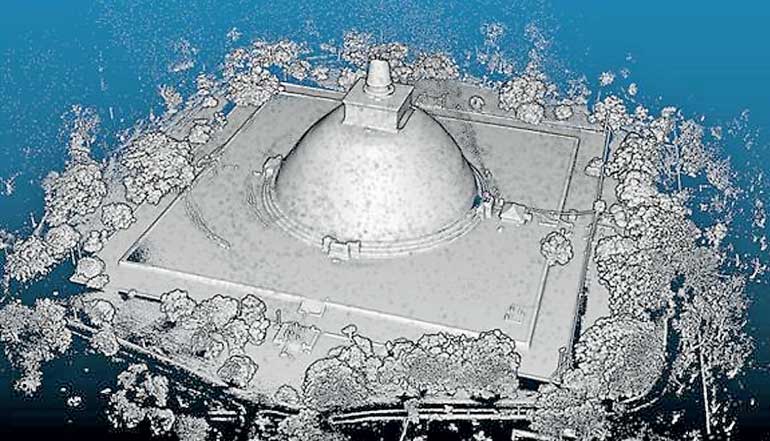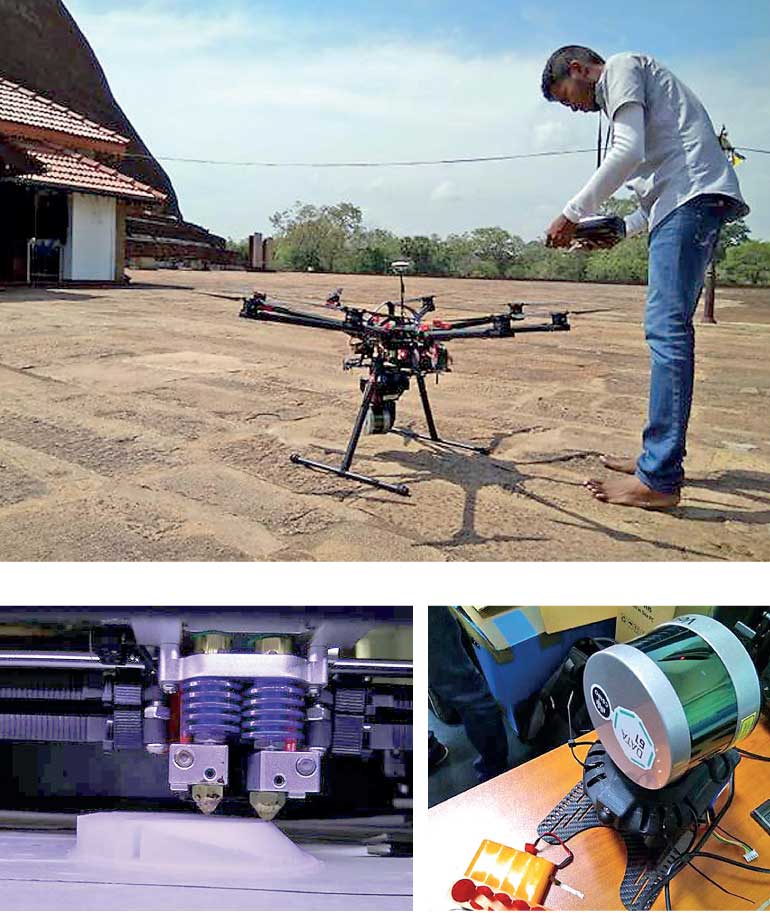Tuesday Apr 29, 2025
Tuesday Apr 29, 2025
Monday, 22 May 2017 00:50 - - {{hitsCtrl.values.hits}}

www.3ders.org: RCS2, a 3D printing company based in Sri Lanka, has teamed up with Sri Lanka’s University of Moratuwa and Australia’s Commonwealth Scientific and Industrial Research Organisation (CSIRO) to 3D scan a number Sri Lankan cultural heritage sites using LIDAR-equipped drones.
Sri Lanka has a rich cultural history, exemplified by its seven UNESCO World Heritage Sites, which include Kandy’s Temple of the Tooth, Sigiriya’s ancient castle and the sacred city of Anuradhapura.
Preservation of sites like these is a top priority for many local historians, who will do anything in their power to ensure that the remarkable buildings and monuments at these heritage sites live on for future generations to appreciate.
But preservation these days is about more than just keeping things clean and secure.
Thanks to modern technologies like 3D scanning and 3D printing, historians and preservationists are now able to create digital copies of virtually any item of historical and cultural significance—from small artifacts in museums to entire buildings.
And while these technologies can’t always save the bricks and mortar of the original structures from damage or decay, they at least ensure that a complete image of the site can persevere through time—potentially forever.
The technology has already been used to make 3D printed replicas of destroyed sections of the ancient city of Palmyra in Syria, most of which was destroyed by ISIS.
RCS2, a 3D printing company based in Sri Lanka, has now carried out the same practice in Sri Lanka, in order to digitally preserve some of the country’s most significant heritage sites. To do so, the company teamed up with two organisations: Sri Lanka’s own University of Moratuwa and CSIRO, a federal agency of Australia.
Together, the three organisations used Light Detection and Ranging (LIDAR) technology to 3D scan a number of archaeological heritage sites in Sri Lanka.

The project, called ‘LIDAR Based 3D Mapping for Nondestructive Heritage Conservation’ involved using drones to 3D scan sites in Jethawanarama Sthupaya, Kuttam Pokuna, Sigiriya, and Polonnaruwa.
According to RCS2, drones were fitted with LIDAR technology and then flown above the heritage sites to capture accurate 3D images. The data was then sent to CloudCompare, an open source 3D point cloud processing software, where it could be turned into clear 3D models.
The organisations participating in the project believe the process serves many purposes.
First and foremost, the massive 3D scanning operation can help keep the historical buildings on their feet. For example, if a section of a structure gets damaged or destroyed, preservationists can now consult the 3D model of the site to see exactly how the damaged area used to look. This will make it easier to find replacement bricks, stone or other materials required to make repairs.
The LIDAR-captured models provide other advantages too. For example, if one of the sites should be completely destroyed, digital 3D models and even 3D printed replicas of the site could be reproduced. While these would be no substitute for the real thing, they would at least provide a comprehensive historical record of the structures.
Such 3D printed models could also have other uses. They could be used as educational tools for teaching about Sri Lankan history or for tourism purposes in order to attract visitors to the actual sites.
After successfully 3D scanning and 3D printing a number of Sri Lankan heritage sites, the collaborative team now hopes to extend the project to include even more locations.
You might never get to visit the Dambulla Cave temple or the ancient city of Polonnaruwa in person, but if your grandchildren choose to, RCS2’s project could prove vital in allowing them to do so.
Discover Kapruka, the leading online shopping platform in Sri Lanka, where you can conveniently send Gifts and Flowers to your loved ones for any event including Valentine ’s Day. Explore a wide range of popular Shopping Categories on Kapruka, including Toys, Groceries, Electronics, Birthday Cakes, Fruits, Chocolates, Flower Bouquets, Clothing, Watches, Lingerie, Gift Sets and Jewellery. Also if you’re interested in selling with Kapruka, Partner Central by Kapruka is the best solution to start with. Moreover, through Kapruka Global Shop, you can also enjoy the convenience of purchasing products from renowned platforms like Amazon and eBay and have them delivered to Sri Lanka.
Discover Kapruka, the leading online shopping platform in Sri Lanka, where you can conveniently send Gifts and Flowers to your loved ones for any event including Valentine ’s Day. Explore a wide range of popular Shopping Categories on Kapruka, including Toys, Groceries, Electronics, Birthday Cakes, Fruits, Chocolates, Flower Bouquets, Clothing, Watches, Lingerie, Gift Sets and Jewellery. Also if you’re interested in selling with Kapruka, Partner Central by Kapruka is the best solution to start with. Moreover, through Kapruka Global Shop, you can also enjoy the convenience of purchasing products from renowned platforms like Amazon and eBay and have them delivered to Sri Lanka.